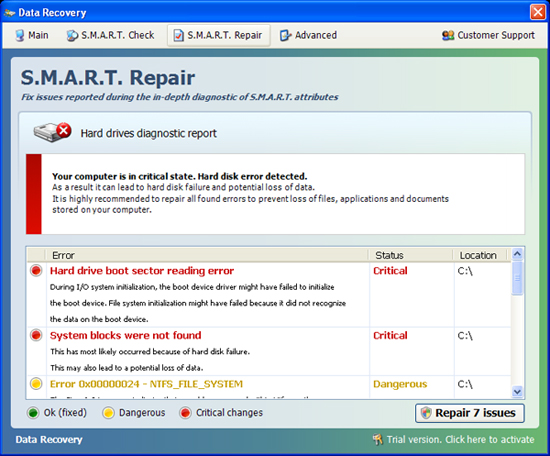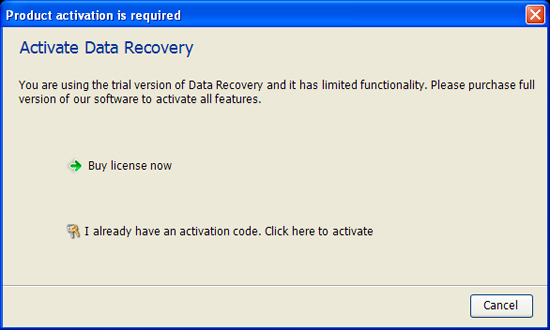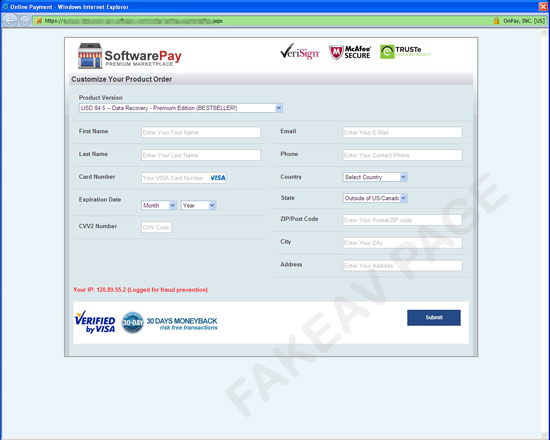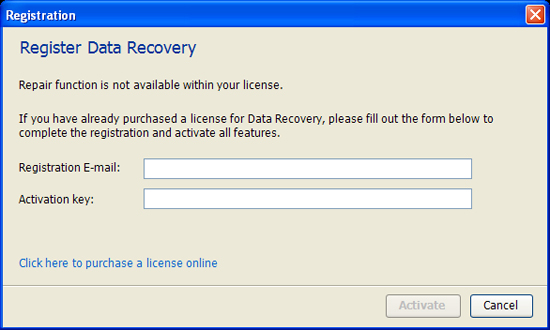TROJ_FAKESYS.GP
Windows 2000, Windows XP, Windows Server 2003


Threat Type: Trojan
Destructiveness: No
Encrypted: Yes
In the wild: Yes
OVERVIEW
Downloaded from the Internet, Dropped by other malware
This Trojan arrives on a system as a file dropped by other malware or as a file downloaded unknowingly by users when visiting malicious sites. It may be dropped by other malware.
It modifies the Internet Explorer Zone Settings.
It deletes the initially executed copy of itself.
TECHNICAL DETAILS
250,368 bytes
EXE
Yes
15 Jun 2012
Displays message/message boxes, Displays graphics/image, Connects to URLs/IPs
Arrival Details
This Trojan arrives on a system as a file dropped by other malware or as a file downloaded unknowingly by users when visiting malicious sites.
It may be dropped by the following malware:
- TROJ_FAKEAV.YAE
Installation
This Trojan drops the following copies of itself into the affected system and executes them:
- %System Root%\Documents and Settings\All Users\Application Data\{Random Name}.exe
(Note: %System Root% is the root folder, which is usually C:\. It is also where the operating system is located.)
It drops the following files:
- %Desktop%\Data_Recovery.lnk
- %Start Menu%\Programs\Data Recovery\Data Recovery.lnk
- %Start Menu%\Programs\Data Recovery\Uninstall Data Recovery.lnk
- %System Root%\Documents and Settings\All Users\Application Data\-{Random Name 1}
- %System Root%\Documents and Settings\All Users\Application Data\-{Random Name 1}r
- %System Root%\Documents and Settings\All Users\Application Data\{Random Name}
- %User Profile%\Application Data\Microsoft\Internet Explorer\Quick Launch\Data_Recovery.lnk
(Note: %Desktop% is the current user's desktop, which is usually C:\Windows\Profiles\{user name}\Desktop on Windows 98 and ME, C:\WINNT\Profiles\{user name}\Desktop on Windows NT, and C:\Documents and Settings\{User Name}\Desktop on Windows 2000, XP, and Server 2003.. %Start Menu% is the current user's Start Menu folder, which is usually C:\Windows\Profiles\{user name}\Start Menu on Windows 98 and ME, C:\WINNT\Profiles\{user name}\Start Menu on Windows NT and C:\Windows\Start Menu or C:\Documents and Settings\{User name}\Start Menu on Windows 2000, XP, and Server 2003.. %System Root% is the root folder, which is usually C:\. It is also where the operating system is located.. %User Profile% is the current user's profile folder, which is usually C:\Windows\Profiles\{user name} on Windows 98 and ME, C:\WINNT\Profiles\{user name} on Windows NT, and C:\Documents and Settings\{user name} on Windows 2000, XP, and Server 2003.)
It creates the following folders:
- %Start Menu%\Programs\Data Recovery
(Note: %Start Menu% is the current user's Start Menu folder, which is usually C:\Windows\Profiles\{user name}\Start Menu on Windows 98 and ME, C:\WINNT\Profiles\{user name}\Start Menu on Windows NT and C:\Windows\Start Menu or C:\Documents and Settings\{User name}\Start Menu on Windows 2000, XP, and Server 2003.)
It terminates the execution of the copy it initially executed and executes the copy it drops instead.
Other System Modifications
This Trojan adds the following registry keys:
HKEY_LOCAL_MACHINE\Software\Microsoft\
ESENT\Process\{Random Name}
HKEY_LOCAL_MACHINE\Software\Microsoft\
ESENT\Process\{Random Name}\
DEBUG
It adds the following registry entries:
HKEY_CURRENT_USER\Software
pth = "{hex values}"
HKEY_CURRENT_USER\Software\Microsoft\
Internet Explorer\Main
Use FormSuggest = "Yes"
HKEY_CURRENT_USER\Software\Microsoft\
Windows\CurrentVersion\Internet Settings
CertificateRevocation = "0"
HKEY_CURRENT_USER\Software\Microsoft\
Windows\CurrentVersion\Internet Settings
WarnonBadCertRecving = "0"
HKEY_CURRENT_USER\Software\Microsoft\
Windows\CurrentVersion\Internet Settings
WarnOnZoneCrossing = "0"
HKEY_LOCAL_MACHINE\Software\Microsoft\
ESENT\Process\{Random Name}\
DEBUG
Trace Level = ""
It modifies the following registry entries:
HKEY_CURRENT_USER\Software\Microsoft\
Windows\CurrentVersion\WinTrust\
Trust Providers\Software Publishing
State = "23e00"
(Note: The default value data of the said registry entry is 23c00.)
Web Browser Home Page and Search Page Modification
This Trojan modifies the Internet Explorer Zone Settings.
Other Details
This Trojan deletes the initially executed copy of itself
NOTES:
Upon installation, it pretends to scan the system for disk errors. After doing the fake scan, it displays the following window:

Upon clicking the Repair 7 Issues button, the following window is displayed:

If the Buy license now button is clicked, it connects to any of the following URLs to get user billing information:
- http://{BLOCKED}osard.com
- http://{BLOCKED}uinesc.com
- http://{BLOCKED}ubfite.com
- http://{BLOCKED}testgolfc.com
- http://{BLOCKED}velar.com
It displays the following window which will contain the form to get the user's billing information:

If the I already have an activation code. Click here to activate button is clicked, the following window is displayed:

SOLUTION
9.200
9.196.03
15 Jun 2012
9.197.00
16 Jun 2012
Step 1
For Windows XP and Windows Server 2003 users, before doing any scans, please make sure you disable System Restore to allow full scanning of your computer.
Step 3
Identify and terminate files detected as TROJ_FAKESYS.GP
- If the detected file is displayed in either Windows Task Manager or Process Explorer but you cannot delete it, restart your computer in safe mode. To do this, refer to this link for the complete steps.
- If the detected file is not displayed in either Windows Task Manager or Process Explorer, continue doing the next steps.
Step 4
Delete this registry key
Important: Editing the Windows Registry incorrectly can lead to irreversible system malfunction. Please do this step only if you know how or you can ask assistance from your system administrator. Else, check this Microsoft article first before modifying your computer's registry.
- In HKEY_LOCAL_MACHINE\Software\Microsoft\ESENT\Process
- {Random Name}
- {Random Name}
Step 5
Delete this registry value
Important: Editing the Windows Registry incorrectly can lead to irreversible system malfunction. Please do this step only if you know how or you can ask assistance from your system administrator. Else, check this Microsoft article first before modifying your computer's registry.
- In HKEY_CURRENT_USER\Software
- pth = "{hex values}"
- pth = "{hex values}"
- In HKEY_CURRENT_USER\Software\Microsoft\Internet Explorer\Main
- Use FormSuggest = "Yes"
- Use FormSuggest = "Yes"
- In HKEY_CURRENT_USER\Software\Microsoft\Windows\CurrentVersion\Internet Settings
- CertificateRevocation = "0"
- CertificateRevocation = "0"
- In HKEY_CURRENT_USER\Software\Microsoft\Windows\CurrentVersion\Internet Settings
- WarnonBadCertRecving = "0"
- WarnonBadCertRecving = "0"
- In HKEY_CURRENT_USER\Software\Microsoft\Windows\CurrentVersion\Internet Settings
- WarnOnZoneCrossing = "0"
- WarnOnZoneCrossing = "0"
Step 6
Restore this modified registry value
Important: Editing the Windows Registry incorrectly can lead to irreversible system malfunction. Please do this step only if you know how or you can ask assistance from your system administrator. Else, check this Microsoft article first before modifying your computer's registry.
- In HKEY_CURRENT_USER\Software\Microsoft\Windows\CurrentVersion\WinTrust\Trust Providers\Software Publishing
- From: State = "23e00"
To: State = "23c00"
- From: State = "23e00"
Step 7
Search and delete this folder
- %Start Menu%\Programs\Data Recovery
Step 8
Search and delete these files
- %Desktop%\Data_Recovery.lnk
- %System Root%\Documents and Settings\All Users\Application Data\-{Random Name 1}
- %System Root%\Documents and Settings\All Users\Application Data\-{Random Name 1}r
- %System Root%\Documents and Settings\All Users\Application Data\{Random Name}
- %User Profile%\Application Data\Microsoft\Internet Explorer\Quick Launch\Data_Recovery.lnk
Step 9
Reset Internet security settings
Step 10
Scan your computer with your Trend Micro product to delete files detected as TROJ_FAKESYS.GP. If the detected files have already been cleaned, deleted, or quarantined by your Trend Micro product, no further step is required. You may opt to simply delete the quarantined files. Please check this Knowledge Base page for more information.
Did this description help? Tell us how we did.

